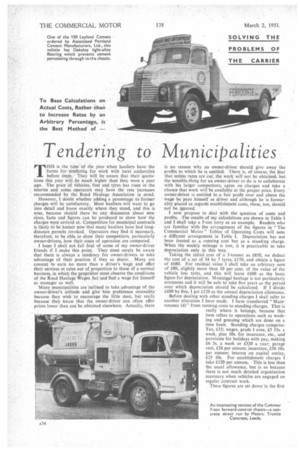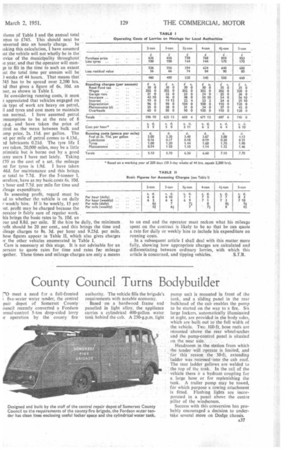Tendering to
Page 60

Page 63

If you've noticed an error in this article please click here to report it so we can fix it.
Municipalities
THIS is the time Of the year when hauliers have the forms for tendering for Work with local authorities before them. They will be aware that their quotations this year will be much higher than they were a year ago. The price of vehicles, fuel and tyres has risen in the interim and some operators may have the rate increases recommended by the Road Haulage Association in mind.
However, I doubt whether adding a percentage to former charges will be satisfactory. Most hauliers will want to go into detail and know exactly where they stand, and this is wise, because should there be any discussion about new rates, facts and figures can be produced to show hoWthe charges were arrived at. Competition for municipal contracts is likely to be keener now that many hauliers have had longdistance permits revoked. Operators may find it necessary, Therefore, to be able to show their competitors, particularly owner-drivers, how their-costs of operation are computed.
1 hope 1 shall not fall foul of some of my owner-driver friends if I make this point. They must surely be aware that there is always a tendency for owner-drivers to take advantage of their position if they so desire.. Many are content to earn no more than a driver's wage and offer their services at rates out of proportion to those Of a normal business, in which the proprietor must observe the conditions of the Road Haulage Wages Act and find a wage for himself as manager as well.
Many municipalities are inclined to take advantage of the owner-driver's attitude and give him preference ostensibly because they wish to encourage the little man, but really because they know that the owner-driver can often offer prices lower than can be obtained elsewhere. Actually, there is no reason why an owner-driver should give away the profits to which he is entitled. There is, of course, the fear that unless rates are cut, the work will not be obtained, but the sensible,thing for an owner-driver to do is to collaborate with his larger competitors, agree on charges and take a chance that work will be available at the proper price. Every owner-driver is entitled to a fair profit over and above the wage he pays himself as driver and although he is favourably placed as regards establishment costs, these, too, should not be ignored.
I now propose to deal with the question of costs and profits. The results of my calculations are shown in Table 1 and I shall take a 5-ton lorry as an example. Readers who are familiar withthe arrangement of the figures in "The Commercial Motor" Tables of Operating Costs will note a diffeirent arrangement in Table I. Depreciation has not been treated as a running cost but as a standing charge. When the weekly mileage is low, it is practicable to take depreciation only in this way.
Taking the initial cost of a 5-tonner as £850, we deduct the cost of a set of 34 by 7 tyres, £170, and obtain a figure of £680. For residual value I shall take an arbitrary sum of £80, slightly more than 10 per cent. of the value of the vehicle less tyres, and this will leave £600 as the basic figure for depreciation. Municipal haulage is not particularly strenuous and it will be safe to take five years as the period over which depreciation should be calculated. If I divide £600 by five, I get £120 as the annual depreciation allowance. Before dealing with other standing charges I shall refer to another alteration I have made. I have transferred "Maintenance (d)" from running costs to standing charges. That is really where it belongs, because that item refers to operations such as washing and greasing which are done on a time basis. Standing charges comprise: Tax, £35; wages, grade I area, £5 13s. a week, plus 10s. for insurance, etc., and provision for holidays with pay, making £6 3s. a week or £320 a year; garage rent, £26 per annum; insurance, £56 10s. per annum; interest on capital outlay, £25 10s. For establishment charges I take £120 per.annum. This is less than the usual allowance, but is so because there is not much detailed organization necessary when vehicles are engaged on regular contract work.
These figures are set down in the first ilumn of Table I and the annual total imes to £745. This should next be
inverted into an hourly-charge. In taking this calculation, I have assumed at the vehicle will not wholly be in the.
:rvioe of the Municipality throughoute year, and that the operator will man-.
x to Mt in the time to such an extent at the total time per annum will be weeks of 44 hours.. That means that 745 has to be spread over 2,200 hrs. that gives a figure of 6s. 10d. an our, as shown in Table I.
in considering running costs, it must appreciated that vehicles engaged on is type of work are heavy on petrol, and tyres and cost more to maintain an normal. I have assumed petrol ansumption to be at the rate of 8 i.p.g.. and have taken the price of trol as the mean between bulk and ainp price, 2s. lid, per gallon. The iSt per mile of petrol conies to 4.I3d., id lubricants 0.2Id. The tyre life I we taken, 20.000 miles, may be a little ptimistie but is borne out by a good iarty users I have met lately. Taking 170 as the cost of a set, the mileage ist for tyres is I.9d. I have taken 46d. for maintenance and this brings. le total to 7.7d. For the 5-tonner I, ierefore, have as my basic, costs 6s. 10d, -1 hour and 7.7d, per mile for time and
iileage expenditure.
In assessing profit, regard must be sd to whether the vehicle is on daily r weekly hire. If it he weekly, 15 per int. profit may be. charged because the aerator is fairly sure of regular work..
his brings the basic rates to 7s. 10d, an our and 8.8d. per mile. If the hire be daily, the minimum . rofit should be 20 per cent., and this brings the time and iileage charges to 8s. 3d. per hour and 9.25d. per mile. hese figures appear in Table II, which also gives charges ir the other vehicles enumerated in Table I.
Care is necessary at this stage. It is not advisable for an perator to quote rates for time and rates for mileage igether. These times and mileage charges are only a means to an end and the operator must reckon what his mileage spent on the contract is likely to be so that he can quote a rate for daily or weekly hire to include his expenditure on running costs.
In a subsequent article I shall deal with this matter more fully, showing how appropriate charges are calculated and differentiating between ordinary lorries, with which this article is concerned, and tipping vehicles.




























































































